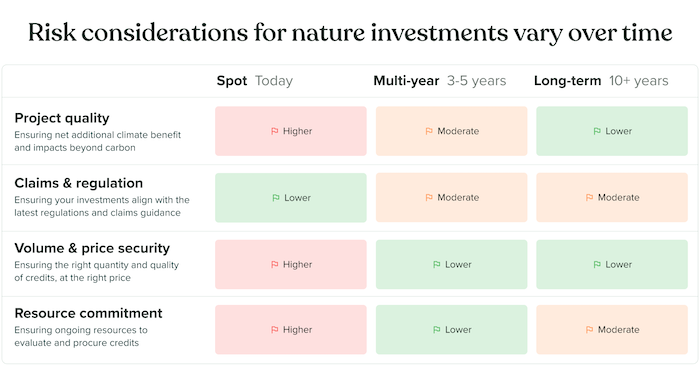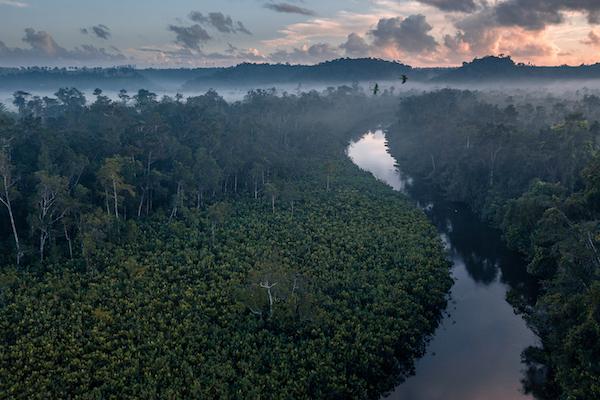This article is sponsored by Pachama.
The paradox of climate action is that it must both be urgent and long-lasting. Companies with climate commitments must develop an investment strategy that reflects this duality of being both immediate in deployment and decadal in scale.
Nature is a proven, scalable solution that delivers both initial and longer-term impact. And like any investment, these solutions present both risks and benefits. Managing a nature portfolio is much like managing a financial portfolio. Companies must understand the risks and be clear on their risk tolerance.
There are many risks and opportunities to consider as you go about building a nature portfolio. Here is how to navigate it all.
Four risk factors to consider
When building a nature portfolio, your organization should address four key factors: project and credit quality; claims and regulation; volume and price security; and resource commitment.
The first risk factor is project and credit quality. High-quality projects are key to achieving meaningful climate impact, making high-integrity claims and mitigating reputational risk. Forest carbon projects are necessary climate solutions, but they face well-documented quality challenges. Some considerations about project and credit quality include data and assumptions used for core crediting factors such as additionality, baseline setting and inventory accounting; how to ensure the project’s impact endures; how the project activity impacts nature biodiversity; and how the project is contributing to local low-carbon economies and ensuring no net harm.
The second risk factor is claims and regulation. The Voluntary Carbon Market (VCM) is subject to evolving regulation and guidance, which could affect the claims corporates make about their investments. Some considerations include how the project’s attributes align with the guidance you have committed to using based on information available today, and if the jurisdiction where the project is located demonstrates support for market-based approaches to climate mitigation.
The third risk factor is volume and price security. The VCM is still evolving, and this can lead to challenges in planning and securing budget for the long term. Corporates need to determine how far out they can confidently forecast market pricing, what volume they’ll need and how project quality fits into budget considerations. Some things to think about internally include what are the key budget plan considerations; what are the different procurement scenarios based on budget and time horizons; and if your internal corporate finance team understands how to account for credit purchases and investments.
And you will want to understand from your suppliers what savings you can capture by locking in long-term supply now versus buying on the spot market; what are the project costs and what is the internal rate of return; and how to help manage volume and delivery risk with longer-term commitments.
The fourth risk factor is resource commitment. It takes significant internal resources to conduct project due diligence, stay up to speed on claims and regulations, and monitor market dynamics. Corporates need to understand ongoing resource needs and secure the budget, expertise and stakeholder buy-in to evaluate and procure credits. You will want to consider which teams need visibility and who are the decision-makers; if you have the technical expertise, procurement setup and legal infrastructure to evaluate project quality and negotiate commercial terms; and what decision-making framework will provide visibility and engage stakeholders.
Accounting for risk across time horizons
The risk dimensions you account for become more or less important depending on your investment time horizon. Companies can make nature-based investments across three time horizons.

Here are the risk dimensions to consider when looking to achieve climate targets over the next decade or more. Some factors require more consideration depending on your procurement strategy. All risk factors can be mitigated, but those categorized as ‘higher’ will require more effort than those that are ‘lower’. Image courtesy of Pachama.
Spot purchases
Spot purchases involve buying credits today to meet near-term (typically annual) or ad hoc needs (for example, to offset emissions of a specific event) based on today's market rates. This requires performing net new due diligence for each procurement.
A key risk factor for spot purchases is project quality. Buyers can mitigate quality risk by evaluating projects and stakeholders against key quality indicators. Ensure projects are registered with an ICROA-approved carbon registry and consider setting the bar at CORSIA-eligible registries. Work with trusted partners and ask for data to back up project claims.
Another risk in a spot market is price transparency. Different service providers often sell the same project. How do you know what price is fair? Ask how the price is set and push them to justify it. Does it include additional services and value-adds? How much goes back to the project?
Multi-year investments
Contracting for credit delivery for the next 3-5 years based on a fixed price and/or volume. Typically, this requires a higher upfront lift across project diligence, market assessment and contract terms alignment. However, it would occur only every three to five years and provides budget and volume security.
A key risk factor for multi-year investments relates to claims and regulation. How might new guidance (for example, around vintages) or regulation (such as the implementation of Article 6 or a carbon tax) influence the investments you select and the claims you make?
Be specific and transparent about your diligence criteria, who you're working with and where your data comes from. The most defensible portfolios are those that can point to how decisions were made based on the best available information at the time. Technology can help you store and report your diligence and impact data. If regulations change, be transparent with your stakeholders!
Long-term investments
Capital investment in projects to generate new supply for your needs. This secures stronger influence over project design and implementation, creates closer ties to projects, and delivers budget and volume security matching long-term net zero targets.
The main risk for long-term investments is whether you have the resources and stakeholder buy-in to make such a prolonged investment. Reduce this risk by looking for parallels in past infrastructure and renewable energy procurements. Engage your legal, finance and procurement teams early and often.
Another consideration is timing. For most companies, making equity-style or 10-year-plus investments into carbon projects is new. It may take between 12–18 months to complete your first long-term contract.
Nature moves at its own pace, and this is particularly the case for reforestation removal projects. Credit delivery timing is affected by the timing of seedling planting, which must align with the right planting season and conditions. Companies that need removal credits for 2030 or 2035 net zero targets should deploy financing now. This isn’t about being proactive — in this scenario, companies have just two planting seasons (2023 and 2024) to get trees in the ground to meet any reasonable volume outputs for credit delivery timelines against net zero target years.
Build a nature portfolio that balances risk and upside
Nature is one of the highest-impact investments a company can make to reverse the trajectory of climate change. We recommend that companies get started with discrete spot purchases to practice navigating stakeholder questions, approval processes and communications. From there, work to secure a multi-year contract with projects you’ve already vetted, and build the internal muscles needed to develop a long-term strategy over the next decade or beyond.
As you build your nature strategy, decide which risk factors are most important to you and look for technology partners to reduce your risk exposure. By thoroughly understanding risk and creating a customized framework for nature investments, your company can meet its targets and make an immediate and lasting impact on climate change.

